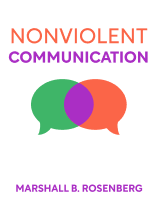

This article is an excerpt from the Shortform book guide to "Nonviolent Communication" by Marshall B. Rosenberg. Shortform has the world's best summaries and analyses of books you should be reading.
Like this article? Sign up for a free trial here .
What is violent communication? How can NVC help you learn to communicate with respect, kindness, and compassion?
Violent communication is any form of communication that blocks our ability to focus on our core humanity and establish real connections. Many of these ideas are so embedded in our language and culture that we’ve lost sight of how they create distance between ourselves and others.
Read about the types of violent communication and what to do instead.
What Is Violent Communication?
In the context of NVC, the words “violent” and “nonviolent” don’t just refer to physical conflict. Any communication that causes pain or harm to anyone (including ourselves) is “violent,” while any communication that stems from true compassion is “nonviolent.” Rosenberg uses the phrase “life-alienating communication” to describe any form of communication that blocks our ability to focus on our core humanity and establish real connections. In this context, there are five types of “life-alienating” or violent communication:
- moralistic judgments;
- comparisons;
- denial of responsibility;
- demands (as opposed to requests);
- compliments.
1. Moralistic Judgments
These judgments stem from the belief that our values are good, and anyone who doesn’t share our values is wrong or bad. This can take the form of blame, labels, insults, criticism, or diagnoses. Moralistic judgments are different from value judgments, which express our beliefs about the world rather than a specific person or group. For example, “violence is bad” is a value judgment; “violent people are evil” is a moralistic judgment.
Making moralistic judgments of others is really a roundabout way of expressing our own values and needs (for example, if we label one political party as “bad,” that’s a way of communicating that their values don’t align with our own). Unfortunately, when we express our values and needs through labels, it creates conflict and moves us even further from getting our needs met.
The moment we label someone, we create distance between them and us, which allows us to forget our common humanity. This distance is dangerous—the root cause of violence is attributing “wrongness” to another person or group.
This kind of violent communication is especially prevalent in societies with strong hierarchies of power because it upholds the notion that some people are “good” (and so “deserve” to be in power) and some people are “bad” (and “deserve” whatever punishments they get).
Rather than label someone based on our own beliefs or analyses, stick to pure observation. For example, instead of saying, “Sarah is so lazy,” say “Sarah has been late to work three times this week.” This is an objective observation of what someone does, says, or believes, rather than a judgment of who they are as a person.
2. Making Comparisons
As the saying goes, “Comparison is the thief of joy.” When you compare yourself to other people, you’re really making a moralistic judgment about whether they are “better” or “worse” than you are.
3. Denial of Responsibility
When you attribute the causes of your feelings and actions to an external source, you deny your own responsibility. For example, the phrases “He makes me so angry,” “I was late because my partner took too long getting ready,” and “I have to wear a skirt to church because I’m a woman” are all denials of responsibility.
One way to practice taking responsibility for your thoughts, feelings, and behavior is by replacing the words “have to” with “choose to.” For example, instead of saying, “I have to get up early,” you can say, “I choose to get up early because getting to work on time is important to me.” That way, you remind yourself that you’re responsible for your own choices and that many of the things you do out of “obligation” are actually choices that serve your higher values.
This exercise might feel strange at first because we’re so used to thinking in terms of obligation. You might even be thinking that some things really are “have tos,” not “choose tos.” But underneath everything you do is a choice you make based on your needs or values. Even something as basic as eating is something you choose to do because you need energy and value being alive.
4. Making Demands
Expressing requests as demands is a form of toxic communication because it implicitly threatens blame and punishment if the person refuses (for example, a parent asking their child to clean up the kitchen is a demand if the child assumes she’ll be punished if she doesn’t obey). In fact, the concepts of reward and punishment themselves are forms of toxic communication because they depend on moralistic judgments. The idea that someone “deserves” reward or punishment stems from our judgment of whether they are “good” or “bad.”
5. Compliments: An Unexpected Form of Violent Communication
Surprisingly, compliments are also a form of violent communication because compliments are really a type of judgment. If someone calls you “brilliant” or “talented,” they’re making a judgment about who you are as a person. The fact that it’s a positive judgment doesn’t change the fact that it prevents you from forming a genuine human connection with the person making the judgment.
Another reason even positive judgments can be toxic is that people often use compliments as a tool of manipulation. Managers might compliment their employees as a way to increase productivity; parents use praise to encourage their children’s “good” behavior and discourage “bad” behavior. But even genuine appreciation and praise can be difficult to accept gracefully because it directly contradicts that self-critical inner voice.
A secondary reason for avoiding positive judgment labels is that they give the person very little information about what they did right. If you tell your child, “You’re so smart,” they may have no idea what they did that earned them the label “smart” and be confused about what you expect of them.
Instead of relying on compliments, you can show appreciation by telling someone which of your needs they’ve met and how that made you feel.
Similarly, when someone else expresses appreciation for you, don’t get caught up in whether or not you “deserve” that appreciation. Reframe their praise by asking them to articulate which needs of theirs you’ve helped to meet and how that made them feel. That way, their appreciation isn’t a judgment of who you are, it’s an expression of gratitude for something you’ve done. By reframing praise in this way, you can celebrate the joy you’re able to bring other people without worrying about their judgment of you.

———End of Preview———
Like what you just read? Read the rest of the world's best book summary and analysis of Marshall B. Rosenberg's "Nonviolent Communication" at Shortform .
Here's what you'll find in our full Nonviolent Communication summary :
- How nonviolent communication lets you have more compassion for yourself
- Why nonviolent communication is the key to fostering authentic connections with others
- The 4 steps to expressing yourself with empathy towards others






